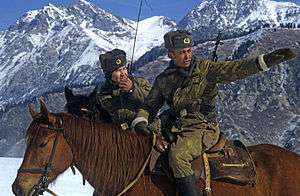Kamuflirovannyi Letnyi Maskirovochnyi Kombinezon

Kamuflirovannyy Letniy Maskirovochnyy Kombinezon or KLMK (Russian: Камуфлированный Летний Маскировочный Комбинезон, literally "Camouflaged Summer Deceptive Coverall") was developed in the 1960s by the Soviet Union to overcome the widespread use of night vision optics and devices by NATO countries. This one-piece camouflage suit was soon to become one of the most widely used and revered devices out of the Soviet Union.
This piece of camouflage was first tested in 1968, and finally given to the Red Army in 1969. It is produced to this day.
This uniform has been seen in several different wars, including the following:
- The Soviet war in Afghanistan
- The war in Karabkah
- The First Chechen War
- The Second Chechen War
- The war in Georgia
It was produced by the Soviet Union, and currently the Russian Federation. It is also seen in some conflicts around the world, and by some Eastern Bloc countries.
KLMK is used in many different roles and by several of the Russian special forces groups. It is often worn by sappers, snipers, and sometimes regular infantry.
Soviet forces saw the odd-looking but effective new camouflage as strikingly odd. The patterns on it sometimes resembled the colossal ears of a bunny rabbit (solnechnye zaychiki), and the look of sunlight on the forest floor. That is how many Soviet soldiers referred to its new slang name (sun bunnies).
Basics on KLMK
- one piece uniform (kombinezon - Combination)
- resembles a Jumpsuit
- reversible
- two color